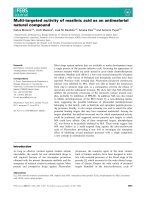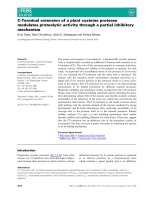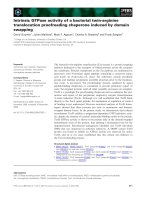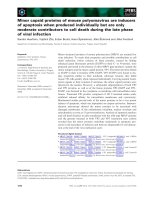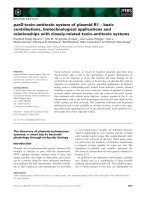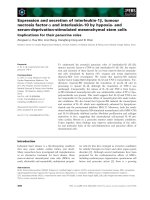Báo cáo khoa học: Does different orientation of the methoxy groups of ubiquinone-10 in the reaction centre of Rhodobacter sphaeroides cause different binding at QA and QB? potx
Bạn đang xem bản rút gọn của tài liệu. Xem và tải ngay bản đầy đủ của tài liệu tại đây (293.56 KB, 7 trang )
Does different orientation of the methoxy groups of ubiquinone-10
in the reaction centre of
Rhodobacter sphaeroides
cause different
binding at Q
A
and Q
B
?
Andre
´
Remy
1
, Rutger B. Boers
2
, Tatiana Egorova-Zachernyuk
2
, Peter Gast
3
, Johan Lugtenburg
2
and Klaus Gerwert
1
1
Lehrstuhl fu
¨
r Biophysik, Ruhr-Universita
¨
t Bochum, Germany;
2
Department of Chemistry, Gorlaeus Laboratories, Leiden University,
the Netherlands;
3
Department of Biophysics, Huygens Laboratory, Leiden University, the Netherlands
The different roles of ubiquinone-10 (UQ
10
) at the primary
and secondary quinone (Q
A
and Q
B
) binding sites of Rho-
dobacter sphaeroides R26 reaction centres are governed by
the protein microenvironment. The 4C¼O carbonyl group
of Q
A
is unusually strongly hydrogen-bonded, in contrast to
Q
B
. This asymmetric binding seems to determine their dif-
ferent functions. The asymmetric hydrogen-bonding at Q
A
can be caused intrinsically by distortion of the methoxy
groups or extrinsically by binding to specific amino-acid side
groups. Different X-ray-based structural models show con-
tradictory orientations of the methoxy groups and do
not provide a clear picture. To elucidate if distortion of
the methoxy groups induces this hydrogen-bonding, their
(ring-)C-O vibrations were assigned by use of site-specifically
labelled [5-
13
C]UQ
10
and [6-
13
C]UQ
10
reconstituted at either
the Q
A
or the Q
B
binding site. Two infrared bands at
1288 cm
)1
and 1264 cm
)1
were assigned to the methoxy
vibrations. They did not shift in frequency at either the Q
A
or
Q
B
binding sites, as compared with unbound UQ
10
.Asthe
frequencies of these vibrations and their coupling are sensi-
tive to the conformations of the methoxy groups, different
conformations of the C(5) and C(6) methoxy groups at the
Q
A
and Q
B
binding sites can now be excluded. Both methoxy
groups are oriented out of plane at Q
A
and Q
B
. Therefore,
hydrogen-bonding to His M219 combined with electrostatic
interactions with the Fe
2+
ion seems to determine the strong
asymmetric binding of Q
A
.
Keywords: electron transfer; Fourier-transform infrared
spectroscopy; isotopic labelling; photosynthetic reaction
centre; ubiquinone.
The photosynthetic reaction centre (RC) of the purple
nonsulphur bacterium Rhodobacter sphaeroides is a trans-
membrane pigment–protein complex, the structure of
which has been determined with up to 2.2 A
˚
resolution
[1–4]. Upon light excitation, an electron is transferred from
the primary donor P (bacteriochlorophyll a dimer) via a
monomeric bacteriochlorophyll a and a bacteriopheo-
phytin a molecule to the primary quinone Q
A
and finally
to the secondary quinone Q
B
. Although ubiquinone-10
(UQ
10
) is found at Q
A
and Q
B
, the two molecules differ in
function: Q
A
is tightly bound to the RC. By accepting one
electron, a semiquinone anion radical Q
A
–•
is created which
quickly transfers the electron to Q
B
.Q
B
is less tightly
bound. After the formation of a nonprotonated semiqui-
none anion radical Q
B
–•
, a second electron and two protons
are accepted here to form a hydroquinone (Q
B
H
2
), which
is finally released from the RC; for a recent review see [5].
To elucidate the protein–cofactor interactions that deter-
mine the different functions of UQ
10
at Q
A
and Q
B
, Fourier-
transform infrared (FTIR) difference spectroscopy has been
applied [6–9]. By the use of UQ
10
specifically
13
C-labelled at
the ring positions 1, 2, 3, and 4, the 1C¼Oand4C¼Oand
2/3C¼C stretching vibrations of UQ
10
in the RC have been
assigned in the Q
A
–
) Q
A
and Q
B
–
) Q
B
difference spectra
[10–13]. At the Q
A
site, the mode dominated by the 4C¼O
vibration is dramatically downshifted compared with
unbound UQ
10
, indicating unusually strong hydrogen-
bonding to the protein environment [10,11]. In contrast,
the 1C¼O group is only weakly bound to the protein. This
asymmetric binding is conserved in the charge-separated
state [10,11]. At the Q
B
site, two fractions of UQ
10
are
found. The minor fraction is loosely bound and almost
unaffected by the protein. In the major fraction, both C¼O
vibrations show symmetric hydrogen-bonding, but weaker
than the hydrogen bond of 4C¼OattheQ
A
site [12,13].
These results for the charge-separated state are supported
by EPR [14] and NMR spectroscopy [15].
It is proposed that this difference in binding governs the
different roles of UQ
10
at the Q
A
and Q
B
sites. However, the
molecular origin of the strong binding of the 4C¼O group is
not clear. The conformation of the C(5) and C(6) methoxy
substituents of UQ
10
may differ at both binding sites as
Correspondence to K. Gerwert, Lehrstuhl fu
¨
r Biophysik, Ruhr-
Universita
¨
t Bochum, Postfach 102148, 44780 Bochum, Germany.
Fax: + 49 234 321 4626, Tel.: + 49 234 322 4461,
E-mail:
Abbreviations: FTIR, Fourier-transform infrared; IR, infrared;
LDAO, lauryldimethylamine N-oxide; Q
A
, primary acceptor quinone;
Q
B
, secondary acceptor quinone; Rb., Rhodobacter;
RC, reaction centre; UQ
10
, ubiquinone-10.
(Received 14 April 2003, revised 25 June 2003, accepted 8 July 2003)
Eur. J. Biochem. 270, 3603–3609 (2003) Ó FEBS 2003 doi:10.1046/j.1432-1033.2003.03746.x
predicted by theoretical studies [16–19], and the different
conformations would then lead to a shift in electron density
towards the 4C¼O group, which weakens the 4C¼O bond
order.
We present Q
A
–
) Q
A
and Q
B
–
) Q
B
difference spectra and
IR spectra of unlabelled and site-specifically
13
C-labelled
UQ
10
at the C5 and C6 positions. Thereby, the correspond-
ing (ring-)C-O vibrations are clearly assigned. The implica-
tions for the C(5) and C(6) methoxy conformations at
Q
A
and Q
B
will be discussed.
Materials and methods
UQ
10
, selectively
13
C-labelled at positions C5 and C6, was
synthesized [20]. RC protein was purified from Rb. sphaero-
ides strain R26 [21]. Either the native UQ
10
was removed
from the Q
B
site or the native UQ
10
was removed from the
Q
A
and Q
B
sites [22]. The Q
A
and Q
B
contents were
determined by fitting the recombination kinetics at 865 nm
after photobleaching of the primary donor to a sum of two
exponentials: A ¼ A
1
exp(–k
1
t
1
)+A
2
exp(–k
2
t
2
). Upon
normalization of the amplitudes A
1
(fast Q
A
–
decay) and A
2
(slow Q
B
–
decay) (A
1
+ A
2
¼ 100%), the fraction of func-
tionally bound secondary quinone was obtained. In the case
of Q
A
reconstitution, the occupancy of the Q
A
site was
analysed by measuring the photobleaching at 865 nm before
and after addition of a 100-fold excess of UQ
0
(¼ 100%
activity) and comparing the amplitudes. The Q
A
and Q
B
contents after reconstitution were always better than 85%.
Samples were prepared for the IR measurements as
previously described [10]. A 45 lL portion of 40 l
M
RCs,
dissolved in buffer [10 m
M
Tris/HCl, 1 m
M
EDTA, 0.025%
(w/v) lauryldimethylamine N-oxide (LDAO), pH 8] was
pipetted on a CaF
2
window, 10-fold concentrated under a
gentle stream of nitrogen, and mixed with 5 lL10m
M
sodium ascorbate/20 m
M
diaminodurene dissolved in the
same buffer as the RCs. After further careful drying to a
final volume of 1 lL, the sample was sealed with another
CaF
2
window and thermostabilized at 283 K or 295 K (for
Q
A
–
) Q
A
or Q
B
–
) Q
B
difference spectra, respectively) in
the FTIR apparatus. The ubiquinones were dissolved in
n-pentane and deposited on a CaF
2
window. After evapor-
ation of n-pentane, the remaining UQ
10
film was measured
in the IR.
IR spectra of unbound ubiquinones, Q
A
–
) Q
A
difference
spectra and Q
B
–
) Q
B
difference spectra were recorded as
reported [10,23,24]. Spectral resolution was 4 cm
)1
.
Double difference spectra were computed as described
[10]. The difference spectra with unlabelled and
13
C-labelled
UQ
10
at the Q
A
or Q
B
sites were normalized on the 1800–
1700 cm
)1
region, which was unaffected by the labelling.
The IR spectra of the unbound UQ
10
were normalized on
the 1500–1350 cm
)1
region, which was unaffected by the
labelling.
Results and discussion
To investigate the influence of the protein microenviron-
ment on UQ
10
at the Q
A
and Q
B
binding sites, first the
vibrational modes of the unbound UQ
10
were determined.
FTIR spectra of pure UQ
10
areshowninFig.1inthe
spectral range in which methoxy vibrations are expected.
The spectrum of unlabelled UQ
10
(Fig. 1a) agrees with the
one published [25]. The absorption spectrum of [5-
13
C]
UQ
10
is displayed in Fig. 1b. Isotopic labelling induces a
frequency shift of the absorption of the labelled group to
lower wave numbers and thereby allows unequivocal band
assignment. Apart from this, bands of nearby groups, the
vibrational modes of which are coupled to the vibrations of
the labelled group, may also be shifted. In fact, various band
shifts of C¼CandC¼O vibrations, which are coupled to the
(ring-)C-O vibrations of the methoxy groups, occur (spectral
range not shown). This is in agreement with previous
assignments of C¼CandC¼O vibrations [10,11]. A detailed
discussion of the C¼CandC¼O vibrations is beyond the
scope of this paper and will be given elsewhere. Here we focus
on the methoxy vibrations only. The strong bands at 1447,
1434 (shoulder) and 1380 cm
)1
are almost unaffected by the
labelling, whereas the bands at 1287 and 1263 cm
)1
are
downshifted to 1283 and 1254 cm
)1
, respectively.
This is visualized in the double difference spectrum
(Fig. 1d). If the spectra of unlabelled and specifically
13
C-labelled UQ
10
are subtracted as described [10], all
unshifted bands should in principle disappear, and only the
shifted bands appear as difference signals in the double
difference spectrum. The two band shifts described above
occur at 1288/1277 cm
)1
and 1264/1252 cm
)1
. The down-
shift from 1264 to 1252 cm
)1
is obvious, whereas the
Fig. 1. IR absorption spectra of (a) unlabelled UQ
10
,(b)[5-
13
C]UQ
10
,
and (c) [6-
13
C]UQ
10
and (d) difference b ) a and (e) difference c ) a.
Inset: structure of site-specifically labelled UQ
10
.
3604 A. Remy et al.(Eur. J. Biochem. 270) Ó FEBS 2003
downshift from 1288 to 1277 cm
)1
is just above the resolu-
tion. However, even though the band is small, the shift is
highly reproducible.
The absorption spectrum of [6-
13
C]UQ
10
(Fig. 1c) is
similar to that of [5-
13
C]UQ
10
(see Fig. 1b), but the band
shifts are slightly different. The band at 1287 cm
)1
shifts to
1280 cm
)1
[in the double difference spectrum (Fig. 1e)
1288/1274 cm
)1
], and the band at 1264 cm
)1
shifts to
1252 cm
)1
.
From the observed frequency shifts caused by site-specific
isotopic labelling, the bands at 1288 and 1263 cm
)1
were
assigned to C(5) and C(6) methoxy vibrations of UQ
10
.
To assign the methoxy vibrations at the Q
A
binding site,
Q
A
–
) Q
A
difference spectra of Rb. sphaeroides RCs recon-
stituted with unlabelled and site-specifically labelled UQ
10
were measured (Fig. 2). The differences between the charge-
separated and the ground state absorption selectively
represent the light-induced absorption changes of the
RCs. Positive bands belong to the charge-separated state,
and negative signals to the ground state.
The Q
A
–
) Q
A
difference spectrum of unlabelled UQ
10
(Fig. 2a) agrees well with the one published [23]. The
Q
A
–
) Q
A
difference spectrum of [5-
13
C]UQ
10
is displayed
in Fig. 2b. As for unbound UQ
10
, various band shifts
of coupled C¼CandC¼OvibrationsofQ
A
occur, in
agreement with previous assignments [10,11] (spectral
range not shown). As both ground state and charge-
separated state contribute to the Q
A
–
) Q
A
difference
spectra, the coupled C-O
–
vibration of Q
A
–
at 1486 cm
)1
[10,11] is also affected. This is not obvious in the
Q
A
–
) Q
A
difference spectra (Fig. 2b,c), but resolved in
the double difference spectra (Fig. 2d,e). Unexpectedly, a
positive signal occurs in the double difference spectra,
whereas a Q
A
–
vibration should cause a negative one. The
C-O
–
vibration of Q
A
–
, however, shows highly coupled
behaviour on isotopic labelling, as described and dis-
cussed previously [10,11,26]. Moreover, the present study
focuses on the methoxy vibrations, and because of the
lack of labelling effects in this region in the spectra of
unbound UQ
10
, any contributions of methoxy vibrations
to this band are most unlikely. Two negative bands at
1287 and 1263 cm
)1
are downshifted due to [5-
13
C]UQ
10
,
to 1273 and 1254 cm
)1
, respectively. The double differ-
ence spectrum (Fig. 2d) shows respective downshifts of
these bands from 1288 to 1277 cm
)1
and from 1263 to
1254 cm
)1
. These effects are due to the ground state of
Q
A
. In principle, contributions of the semiquinone state
Q
A
–
may also occur in the difference spectra, but their
frequencies are probably below 1000 cm
)1
,sotheyare
not observed in this study.
The Q
A
–
) Q
A
difference spectrum of [6-
13
C]UQ
10
is
displayed in Fig. 2c. This spectrum is similar to that of
[5-
13
C]UQ
10
at the Q
A
site (see Fig. 2b). As in the case of
[5-
13
C]UQ
10
, the same band shifts down to 1273 and
1254 cm
)1
occur. In the double difference spectrum
(Fig. 2e), the bands at 1287 and 1263 cm
)1
are downshifted
to 1274 and 1254 cm
)1
, respectively.
Therefore, the bands at 1287/88 and 1263 cm
)1
are
assigned to C(5) and C(6) methoxy vibrations of UQ
10
at
the Q
A
binding site. This assignment agrees with the
methoxy vibrations of unbound UQ
10
.
The Q
B
–
) Q
B
difference spectrum of Rb. sphaeroides RCs
reconstituted with unlabelled UQ
10
is displayed in Fig. 3a. It
agrees well with the one published [24].
The Q
B
–
) Q
B
difference spectrum of [5-
13
C]UQ
10
is
shown in Fig. 3b. As for Q
A
–
) Q
A
, band shifts of coupled
C¼C, C¼OandC-O
–
(1479 cm
)1
) vibrations occur in
agreement with former assignments [12,13] (spectral range
partially not shown). As for Q
A
–
) Q
A
,intheQ
B
–
) Q
B
difference spectrum also two negative bands are down-
shifted due to [5-
13
C]UQ
10
from 1290 to 1277 cm
)1
and
from 1264 to 1253 cm
)1
. This is better visualized in the
double difference spectrum below (Fig. 3d). The double
difference spectrum shows downshifts from 1289 to
1277 cm
)1
and from 1265 to 1252 cm
)1
.
The Q
B
–
) Q
B
difference spectrum of [6-
13
C]UQ
10
is
displayed in Fig. 3c. This spectrum is similar to that of
[5-
13
C]UQ
10
at the Q
B
site (see Fig. 3b), and the same band
shifts to 1277 and to 1253 cm
)1
are seen. Also in the
double difference spectrum (Fig. 3e) the bands at 1288
and 1265 cm
)1
are downshifted to 1277 and 1252 cm
)1
,
respectively.
Therefore, the bands at 1288/89 and 1265 cm
)1
are
assigned to C(5) and C(6) methoxy vibrations of UQ
10
at
the Q
B
binding site. This is in agreement with the assignment
of the methoxy vibrations of UQ
10
at the Q
A
site and of the
unbound UQ
10
.
Fig. 2. Q
A
–
) Q
A
difference spectra of Rb. sphaeroides RCs reconstitu-
ted with (a) unlabelled UQ
10
,(b)[5-
13
C]UQ
10
, and (c) [6-
13
C]UQ
10
at the
Q
A
site and (d) double difference b ) a and (e) double difference c ) a.
Inset: structure of site-specifically labelled UQ
10
.
Ó FEBS 2003 Assignment of methoxy vibrations of ubiquinone-10 (Eur. J. Biochem. 270) 3605
Conclusion
Assignment of methoxy vibrations
In the spectra presented, the bands at 1288 and 1264 cm
)1
show frequency shifts due to labelling at the C5 or C6
position, whereas all the other ring carbon vibrations
show smaller shifts or do not shift at all [10–13,26]. The
bands at 1288 and 1264 cm
)1
can now unambiguously be
assigned to (ring-)C-O vibrations of the C(5) and C(6)
methoxy groups. The vibration at 1264 cm
)1
has been
assigned to a C-C-ring vibration by normal mode analysis
[27,28]. In contrast, Breton et al.proposedthisbandtobe
a combined (ring-)C-C vibration and C-O vibration of the
methoxy groups [29]. The latter proposal agrees with our
results.
We did not observe an isolated vibration, but both
methoxy vibrations were coupled to various (ring-)C-C
vibrations. As the band at 1264 cm
)1
shows larger shifts due
to isotopic labelling of the other ring carbons than the band
at 1288 cm
)1
[10–13,26], we conclude that the vibration at
1264 cm
)1
is more strongly coupled than the vibration at
1288 cm
)1
. Interestingly, on labelling one of the methoxy-
bearing carbons, both bands shift. This indicates that the
vibrations of both methoxy groups are strongly coupled and
cannot be distinguished.
That these two bands do not shift on exchanging the
methoxy substituents into one or two ethoxy groups [30]
excludes a significant contribution of the O-CH
3
vibrations
and thus favours the assignment to the (ring-)C-O stretch-
ing mode as the dominant mode at 1288 and 1264 cm
)1
.
The C-O-C bending and O-C-H bending vibrations may
also contribute to these bands. However, the clear shifts
show that the (ring-)C-O vibration is the dominating mode,
as expected by normal mode analysis (M. Nonella,
P. Tavan, personal communication, referring to [31]). In
this normal mode analysis work [31], only the C¼Cand
C¼O vibrations of the quinones in the RC are reported,
but the calculations include the methoxy vibrations of the
quinones (M. Nonella, P. Tavan, personal communica-
tion), which are useful for the conclusions drawn in this
work. Therefore reference [31] is quoted in combination
with the cross reference to the personal communication to
make clear that our conclusions are not only based on the
published data [31], but also on the information commu-
nicated by M. Nonella and P. Tavan which complements
the published calculations [31].
The two bands at 1450 and 1436 cm
)1
have been
proposed to arise from CH
3
and CH
2
deformation vibra-
tions of the isoprenoid chain [32]. As they disappear in
duroquinone, which is lacking the methoxy groups, they
have tentatively been assigned to the O-CH
3
vibration of the
methoxy groups [29]. Duroquinone, however, lacks not only
the methoxy groups, but also the whole isoprenoid chain.
FTIR difference spectroscopy using specifically labelled
UQ
10
revealed that only the isoprenoid chain is responsible
for both bands at 1450 and 1436 cm
)1
[33]. In addition, our
measurements of [5-
13
C]UQ
10
and [6-
13
C]UQ
10
do not
show any shift of these bands due to isotopic labelling and
thus support the latter assignment.
Implications for the binding of UQ
10
at the Q
A
and Q
B
binding sites
How can chemically identical molecules take over different
functions in the RC? FTIR difference spectroscopy identi-
fied a large downshift of the 4C¼O stretching vibration of
Q
A
by 60 cm
)1
[10,11], indicating strong asymmetric
binding of UQ
10
at the Q
A
site, in contrast to symmetric,
weaker binding of UQ
10
at the Q
B
site [12,13].
To explain the difference in binding, it has been proposed
that the conformation of the two methoxy substituents is
sterically hindered at the Q
A
site, and therefore electrostatic
and/or steric interactions between one methoxy group and
the oxygen at C4 lower the binding order of the carbon C4
and strengthen the downshift of the 4C¼O mode [10,11].
In principle, X-ray-based structural models of the reaction
centre of Rb. sphaeroides should provide the methoxy
orientations of UQ
10
at the Q
A
and Q
B
binding sites.
However, there are a large variety of contradicting confor-
mations in the different structural models: in refs [1,2] one
methoxy group is shown within the plane of the quinone ring
and the other out of the plane, as shown in Fig. 4 (upper
part), whereas refs [3,34–37] show both methoxy substituents
in out-of-plane conformations (Fig. 4, lower part). However,
even within one type there are several variations. The
downwards or upwards orientation within these two
classes, in-plane/out-of-plane and out-of-plane/out-of-plane,
Fig. 3. Q
B
–
) Q
B
difference spectra of Rb. sphaeroides RCs reconstitu-
ted with (a) unlabelled UQ
10
,(b)[5-
13
C]UQ
10
, and (c) [6-
13
C]UQ
10
at the
Q
A
site and (d) double difference b ) a and (e) double difference c ) a.
Inset: structure of site-specifically labelled UQ
10
.
3606 A. Remy et al.(Eur. J. Biochem. 270) Ó FEBS 2003
respectively, is found in all permutations within the different
structural models. From the contradictory picture of the
different structural models with regard to the methoxy
orientations, we conclude that the resolution of the X-ray-
based structural models of the RC is too low to discriminate
between the different orientations of the methoxy groups.
We used FTIR spectroscopy to determine these orienta-
tions. The methoxy vibrations assigned surprisingly appear
at almost the same frequencies in the unbound UQ
10
(1287 cm
)1
, 1264 cm
)1
) and in the protein-bound UQ
10
at
the Q
A
(1287/88 cm
)1
, 1263 cm
)1
)andQ
B
(1288/89 cm
)1
,
1265 cm
)1
) binding sites. If the conformation of one or both
methoxy groups were greaty affected in the protein-bound
case by steric hindrance or electrostatic interactions, one
would expect a clear shift in frequency compared with the
unbound UQ
10
. Vibrations of proteins and of their cofac-
tors are very sensitive to changes in conformation [6–9].
There have been no experimental investigations of how
different methoxy group conformations influence the
frequency of the methoxy vibrations.
However, the effect of different conformations of the
UQ
10
methoxy groups on the IR frequency have been
studied in model compounds [16,17]. The calculations show
that the frequencies and the coupling of the (ring-)C-O
methoxy vibrations are sensitive to their orientations. As the
same frequency and coupling are observed in unbound
UQ
10
,atQ
A
and at Q
B
, the methoxy groups must have the
same orientation. Therefore, different orientations of UQ
10
at Q
A
and Q
B
can be excluded. If one methoxy substituent is
in plane and the other is in an out-of-plane conformation
relative to the quinone ring (conformation A in [2], Fig. 4),
the C(5) and C(6) (ring-)C-O modes occur at different
frequencies and they are not coupled (M. Nonella, P. Tavan,
personal communication, referring to [31], see above).
Therefore, isotopic labelling at either the C(5) or the C(6)
methoxy group would lead to different shifts depending on
the labelling position. This is not observed.
In contrast, when both methoxy substituents are in out-
of-plane positions (conformation B in [3], Fig. 4), the C(5)
and C(6) (ring-)C-O vibrations of the methoxy groups are
coupled and at the same position (M. Nonella, P. Tavan,
personal communication, referring to [31], see above).
Isotopic labelling should lead to identical shifts independent
of the labelled group. This is experimentally observed in
unbound UQ
10
as well as at the Q
A
and the Q
B
binding sites.
Therefore, we conclude that the same conformation is
present in unbound UQ
10
andinprotein-boundUQ
10
at the
Q
A
and Q
B
binding sites. The agreement with the above
calculations indicates that both methoxy substituents are
in an out-of-plane conformation as in [3]. Furthermore,
these theoretical studies confirm our suggestion that the
(ring-)C-O vibration mainly contributes to the assigned
methoxy vibrations.
This is an example of how IR spectroscopy can give
detailed local structural information which complements the
data obtained by X-ray crystallography.
A further FTIR approach proposes Ile M265 to be
constitutive for the electrostatic interaction with UQ
10
at Q
A
[38], as mutation of this site to Thr or Ser leads to an upshift
of about 4–5 cm
)1
of the 4C¼Ovibration.
It is not the methoxy group orientation, but strong
binding to His M219 at Q
A
(Fig. 5), and His L190 at Q
B
combined with electrostatic interactions with the Fe
2+
ion
and with further amino-acid side chains in the Q
A
binding
niche (e.g. Ile M265) that may explain the strong binding of
UQ
10
at the Q
A
site. Site-directed mutagenesis of these
groups should provide a clear answer.
Acknowledgements
Drs M. Nonella and P. Tavan are acknowledged for providing
unpublished information about normal mode analysis studies on
ubiquinones. This work was financially supported by the Deutsche
Forschungsgemeinschaft (SFB 480-C3).
References
1.Feher,G.,Allen,J.P.,Okamura,M.Y.&Rees,D.C.(1989)
Structure and function of bacterial photosynthetic reaction cen-
tres. Nature 339, 111–116.
2. Ermler, U., Fritzsch, G., Buchanan, S. & Michel, H. (1994)
Structure of the photosynthetic reaction centre from Rhodobacter
sphaeroides at 2.65 A
˚
resolution: cofactors and protein–cofactor
interactions. Structure 2, 925–936.
Fig. 5. Orientation of UQ
10
and its methoxy groups at the Q
A
and Q
B
binding sites [3] including the connecting His L190–Fe
2+
–His M219
complex.
Fig. 4. UQ
10
(isoprenoid chain cut) of two structural models. In the
upper model, the C(5) methoxy group is out of plane, whereas the C(6)
methoxy group is orientated in the ring plane [2]. In reference [3] the
methoxy groups point upwards. The IR results show that the methoxy
groups are orientated as proposed by reference [3] in the ground state.
Ó FEBS 2003 Assignment of methoxy vibrations of ubiquinone-10 (Eur. J. Biochem. 270) 3607
3. Stowell, M.H.B., McPhilipps, T.M., Rees, D.C., Soltis, S.M.,
Abresch, E. & Feher, G. (1997) Light-induced structural changes
in photosynthetic reaction center: implications for mechanism of
electron-proton transfer. Science 276, 812–816.
4. Kuglstatter, A., Ermler, U., Michel, H., Baciou, L. & Fritzsch, G.
(2001) X-ray structure analyses of photosynthetic reaction center
variants from Rhodobacter sphaeroides: structural changes induced
by point mutations at position L209 modulate electron and proton
transfer. Biochemistry 40, 4253–4260.
5. Okamura, M.Y., Paddock, M.L., Graige, M.S. & Feher, G. (2000)
Proton and electron transfer in bacterial reaction centers. Biochim.
Biophys. Acta 1458, 148–163.
6. Gerwert, K. (1993) Molecular reaction mechanisms of proteins as
monitored by time-resolved FTIR spectroscopy. Curr. Opin.
Struct. Biol. 3, 769–773.
7. Ma
¨
ntele, W. (1996) Infrared and Fourier-transform infrared
spectroscopy. In Biophysical Techniques in Photosynthesis (Amesz,
J. & Hoff, A.J., eds), pp 137–160. Kluwer Academic Publishers,
Dordrecht.
8. Vogel, R. & Siebert, F. (2000) Vibrational spectroscopy as a tool
for probing protein function. Curr. Opin. Chem. Biol. 4, 518–523.
9. Barth, A. & Zscherp, C. (2002) What vibrations tell us about
proteins. Q. Rev. Biophys. 35, 369–430.
10. Brudler, R., de Groot, H.J.M., van Liemt, W.B.S., Steggerda,
W.F.,Esmeijer,R.,Gast,P.,Hoff,A.J.,Lugtenburg,J.&Ger-
wert, K. (1994) Asymmetric binding of the 1- and 4-C¼Ogroups
of Q
A
in Rhodobacter sphaeroides R26 reaction centres monitored
by Fourier transform infra-red spectroscopy using site-specific
isotopically labelled ubiquinone-10. EMBO J. 13, 5523–5530.
11. Breton, J., Boullais, C., Burie, J R., Nabedryk, E. & Mioskowski,
C. (1994) Binding sites of quinones in photosynthetic bacterial
reaction centers investigated by light-induced FTIR difference
spectroscopy: assignment of the interactions of each carbonyl of
Q
A
in Rhodobacter sphaeroides using site-specific
13
C-labelled
ubiquinone. Biochemistry 33, 14378–14386.
12. Brudler, R., de Groot, H.J.M., van Liemt, W.B.S., Gast, P., Hoff,
A.J., Lugtenburg, J. & Gerwert, K. (1995) FTIR spectroscopy
shows weak symmetric hydrogen bonding of the Q
B
carbonyl
groups in Rhodobacter sphaeroides R26 reaction centres. FEBS
Lett. 370, 88–92.
13. Breton, J., Boullais, C., Berger, G., Mioskowski, C. & Nabedryk,
E. (1995) Binding sites of quinones in photosynthetic bacterial
reaction centers investigated by light-induced FTIR difference
spectroscopy: symmetry of the carbonyl interactions and close
equivalence of the Q
B
vibrations in Rhodobacter sphaeroides and
Rhodopseudomonas viridis probed by isotope labeling. Biochem-
istry 34, 11606–11616.
14. van den Brink, J.S., Spoyalov, A.P., Gast, P., van Liemt, W.B.S.,
Raap, J., Lugtenburg, J. & Hoff, A.J. (1994) Asymmetric binding
of the primary acceptor quinone in reaction centers of the photo-
synthetic bacterium Rhodobacter sphaeroides R26, probed with
Q-band (35 GHz) EPR spectroscopy. FEBS Lett. 353, 273–276.
15. van Liemt, W.B.S., Boender, G.J., Gast, P., Hoff, A.J., Lugten-
burg, J. & de Groot, H.J.M. (1995)
13
C magic angle spinning
NMR characterization of the functionally asymmetric Q
A
binding
in Rhodobacter sphaeroides R26 photosynthetic reaction centers
using site-specific
13
C-labelled ubiquinone-10. Biochemistry 34,
10229–10236.
16. Nonella, M. & Bra
¨
ndli, C. (1996) Density functional investigation
of methoxy-substituted p-benzoquinones: conformational analysis
and harmonic force field of 2-methoxy- and 2,3-dimethoxy-1,4-
benzoquinone. J. Phys. Chem. B 100, 14549–14559.
17. Burie, J R., Boullais, C., Nonella, M., Mioskowski, C., Nabe-
dryk, E. & Breton, J. (1997) Importance of the conformation of
methoxy groups on the vibrational and electrochemical properties
of ubiquinones. J. Phys. Chem. B 101, 6607–6617.
18. Boullais, C., Nabedryk, E., Burie, J R., Nonella, M., Mioskow-
ski, C. & Breton, J. (1998) Site-specific isotope labeling demon-
strates a large mesomeric resonance effect of the methoxy groups
on the carbonyl frequency of ubiquinones. Photosynth. Res. 55,
247–252.
19. Nonella, M., Boullais, C., Mioskowski, C., Nabedryk, E. &
Breton, J. (1999) Vibrational spectrum and torsional potential of
2-methoxy-3-methyl-1,4-benzoquinone. J. Phys. Chem. B 103,
6363–6370.
20. Boers,R.B.,Gast,P.,Hoff,A.J.,deGroot,H.J.M.&Lugtenburg,
J. (2002) Synthesis and spectroscopic characterization of [5-
13
C]-
and [6-
13
C]-ubiquinone-10 for studies of bacterial photosynthetic
reaction centers. Eur. J. Org. Chem. 2002, 189–202.
21. Feher, G. & Okamura, M.Y. (1978) The Photosynthetic Bacteria
(Clayton, R.K. & Sistrom, W.R., eds), pp. 349–386. Plenum, New
York.
22. Okamura, M.Y., Isaacson, R.A. & Feher, G. (1975) Primary
acceptor in bacterial photosynthesis: obligatory role of ubiquinone
in photoactive reaction centers of Rhodopseudomonas spheroides.
Proc. Natl. Acad. Sci. USA 72, 3491–3495.
23. Breton, J., Thibodeau, D.L., Berthomieu, C., Ma
¨
ntele, W.,
Vermeglio, A. & Nabedryk, E. (1991) Probing the primary qui-
none environment in photosynthetic bacterial reaction centers by
light-induced FTIR difference spectroscopy. FEBS Lett. 278,
257–260.
24. Breton, J., Berthomieu, C., Thibodeau, D.L. & Nabedryk, E. (1991)
Probing the secondary quinone (Q
B
) environment in photo-
synthetic bacterial reaction centers by light-induced FTIR dif-
ference spectroscopy. FEBS Lett. 288, 109–113.
25. Keller, R.J. (ed.) (1986) The Sigma Library of FT-IR Spectra.Vol.
1, p. 929. Sigma Chemical Co., St Louis.
26. Remy, A. (1998) FTIR-spektroskopische und molekularbio-
logische Untersuchungen zum Elektronen- und Protonentransfer
im bakteriellen photosynthetischen Reaktionszentrum von Rhodo-
bacter sphaeroides. Thesis, Ruhr-Universita
¨
t Bochum, Germany.
27. Becker,E.D.,Charney,E.&Anno,T.(1965)Molecularvibra-
tions of quinones. VI. A vibrational assignment for p-benzoqui-
none and six isotopic derivatives. Thermodynamic functions of
p-benzoquinone. J. Chem. Phys. 42, 942–944.
28. Chipman, D.M. & Prebenda, M.F. (1986) Structures and
fundamental vibrations of p-benzoquinone and p-benzoquinone
radical anion from ab initio calculations. J. Phys. Chem. 90, 5557–
5560.
29. Breton, J., Burie, J R., Boullais, C., Berger, G. & Nabedryk, E.
(1994) Binding sites of quinones in photosynthetic bacterial
reaction centers investigated by light-induced FTIR difference
spectroscopy: binding of chainless symmetrical quinones to the
Q
A
site of Rhodobacter sphaeroides. Biochemistry 33, 12405–
12415.
30. Pennock, J.F. (1965) Spectroscopy of quinones and related sub-
stances. II. Infrared absorption spectra and nuclear magnetic
resonance spectra. In Biochemistry of Quinones (Morton, R.A.,
ed.), pp. 67–87. Academic Press, New York.
31. Nonella, M., Mathias, G., Eichinger, M. & Tavan, P. (2003)
Structures and vibrational frequencies of the quinones in Rb.
sphaeroides derived by a combined density functional/molecular
mechanics approach. J. Phys. Chem. B 107, 316–322.
32. Bellamy, L.J. (1980) The infrared spectra of complex molecules.
Kluwer Academic Publishers, London.
33. Brudler, R. (1996) Charakterisierung der Chinonbindestellen
im photosynthetischen Reaktionszentrum von Rhodobacter
sphaeroides mit Hilfe von statischer und zeitaufgelo
¨
ster
FTIR-Differenzspektroskopie. PhD Thesis, Ruhr-Universita
¨
t
Bochum, Germany.
34. Chang, C H., El-Kabbani, O., Tiede, D., Norris, J. & Schiffer, M.
(1991) Structure of the membrane-bound protein photosynthetic
3608 A. Remy et al.(Eur. J. Biochem. 270) Ó FEBS 2003
reaction center from Rhodobacter sphaeroides. Biochemistry 30,
5352–5360.
35. Chirino, A.J., Lous, E.J., Huber, M., Allen, J.P., Schenck, C.C.,
Paddock, M.L., Feher, G. & Rees, D.C. (1994) Crystallo-
graphic analyses of site-directed mutants of the photosynthetic
reaction center from Rhodobacter sphaeroides. Biochemistry 33,
4584–4593.
36. Arnoux, B., Gaucher, J.F., Ducruix, A. & Reiss-Husson, F. (1995)
Structure of the photochemical reaction centre of a spheroidene-
containing purple bacterium, Rhodobacter sphaeroides Y, at 3
Angstrom resolution. Acta Crystallogr. D 51, 368–379.
37. Camara-Artigas, A., Brune, D. & Allen, J.P. (2002) Interactions
between lipids and bacterial reaction centers determined by pro-
tein crystallography. Proc.Natl.Acad.Sci.USA99, 11055–11060.
38. Takahashi, E., Wells, T.A. & Wraight, C.A. (2001) Protein control
of the redox potential of the primary quinone acceptor in reaction
centers from Rhodobacter sphaeroides. Biochemistry 40, 1020–
1028.
Ó FEBS 2003 Assignment of methoxy vibrations of ubiquinone-10 (Eur. J. Biochem. 270) 3609
